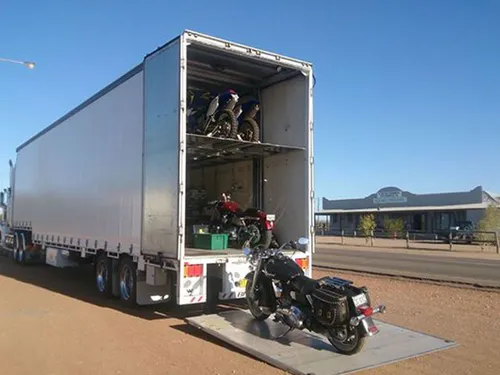Car shipping plays a pivotal role in the global automotive trade, bridging manufacturers and markets. As the automotive industry expands, so does the demand for efficient transport methods. There’s a myriad of shipping options available, each with its unique advantages and challenges. This article delves into a comparative analysis, shedding light on these methods. Such insights equip stakeholders to make informed decisions, optimizing cost, efficiency, and safety.
Open Carrier Transport
Open carrier transport is the most recognizable face of car shipping. Picture those multi-level trucks on highways, loaded with vehicles; that’s it. This method dominates domestic routes, offering a balance between efficiency and cost.
Pros
- Cost-Effective: Among the shipping methods, open carriers often provide the most bang for your buck. Their widespread availability drives competitive pricing.
- Versatility: From sedans to SUVs, open carriers accommodate a diverse range of vehicles. It’s the go-to choice for everyday cars.
- Speed: With more open carriers on the road, finding a timely shipment is often easier. It’s a boon for those in a pinch.
Cons
- Weather Vulnerability: Cars are exposed to the elements. Rain, snow, or sun, vehicles face it all, which can affect their exterior.
- Potential Scratches: While rare, minor damages like scratches from road debris can occur. It’s a trade-off for the method’s affordability.
Enclosed Carrier Transport
Enclosed carrier transport epitomizes premium car shipping. Unlike its open counterpart, these carriers shield vehicles within a covered trailer. Often seen transporting high-end vehicles, they offer an elevated level of protection. Interestingly, the origins of enclosed transport trace back to collectors wanting pristine delivery for their classic treasures.
Pros
- Superior Protection: Enclosed carriers are a fortress against weather. Rain, sleet, or hail, the vehicle remains untouched.
- Guarded Against Debris: Road debris, a menace on highways, poses no threat here. The vehicle’s paint job remains immaculate.
- Tailored for the Elite: Luxury, vintage, or custom cars? This method is their best friend. In fact, many auto shows rely on enclosed transport for their prized exhibits.
Cons
- Hefty Price Tag: Quality comes at a cost. Enclosed transport can be significantly pricier than open carriers.
- Scarce Availability: Finding an enclosed carrier isn’t always straightforward. Their specialized nature means fewer options on the road.
Roll-on/Roll-off (RoRo) Shipping
RoRo shipping, a term derived from the process itself, is a mainstay in overseas vehicle transport. Imagine a massive floating parking garage. Vehicles drive on at the origin port and roll off at the destination. Historically, RoRo ships were first used in World War II, streamlining the transport of large military equipment.
Pros
- Bulk Efficiency: RoRo ships can transport thousands of vehicles simultaneously, making it a favorite for manufacturers.
- Simplicity: Vehicles power themselves on and off, eliminating the need for cranes or lifts.
Cons
- Port Limitations: RoRo services are bound to major ports, restricting their reach.
- Scheduling Hiccups: Given the vast quantities, delays, though infrequent, can be substantial when they occur.
Container Shipping
Container shipping offers a cocoon of security for vehicles, especially during long sea voyages. Vehicles are placed inside steel containers, safeguarding them from external threats. Did you know? The modern shipping container concept was introduced in the 1950s, revolutionizing global trade.
Pros
- Fortified Protection: Containers shield vehicles from saltwater, weather, and potential mishaps on deck.
- Personal Belongings: An added perk is the ability to store personal items in the same container, a boon for relocating individuals.
Cons
- Premium Pricing: The enhanced protection comes with a steeper price compared to RoRo.
- Time-Intensive: Loading and securing a vehicle inside a container is meticulous, often lengthening the shipping process.
Factors to Consider When Choosing a Shipping Method
Budget
Every shipping method has its price point. Open carriers typically offer the most economical rates, while enclosed and container shipping lean towards the premium end. Interestingly, the shipping industry’s pricing can fluctuate seasonally, much like airline tickets.
Vehicle Type
The vehicle’s nature dictates the ideal method. Everyday cars often find their way on open carriers. However, a vintage Ferrari or a limited-edition Bugatti would likely nestle in an enclosed space. It’s akin to choosing between economy and first-class based on the value of the cargo.
Destination
The journey’s endpoint plays a pivotal role. For domestic transits, road-based methods dominate. However, international shipments might lean towards RoRo or container shipping. Did you know? Some remote destinations might only be accessible via specific ports, narrowing down options.
Timeframe
Urgency is a determining factor. Open carriers, being more prevalent, might offer quicker dispatch times. On the flip side, container shipping, with its meticulous loading process, might introduce delays. It’s a balance between speed and protection.
Safety Concerns
Every method boasts its safety protocols. However, the degree varies. Enclosed and container methods offer heightened protection, shielding vehicles from external threats. Additionally, insurance coverage nuances differ across methods, warranting a closer look to ensure adequate protection.
In essence, choosing a shipping method is a multifaceted decision. It requires a blend of budgetary considerations, vehicle specifications, destination logistics, time constraints, and safety priorities. Making an informed choice ensures the vehicle’s journey is as smooth as its ride.
Navigating the intricate landscape of car shipping requires a blend of knowledge and strategy. Each method, from the ubiquitous open carriers to the protective embrace of container shipping, serves a unique purpose. It’s fascinating to note that the global car shipping industry, valued at billions, hinges on these choices daily. Stakeholders, be it manufacturers or individual car enthusiasts, must weigh factors like budget, vehicle type, destination, and safety to chart the optimal course. As the automotive world evolves, so will these transport methods, continually adapting to serve an ever-growing demand. In this dynamic arena, staying informed is not just beneficial—it’s imperative. After all, in the world of car shipping, knowledge truly steers the way.



